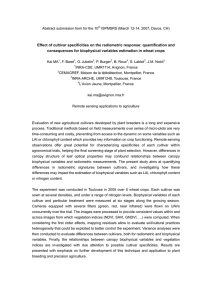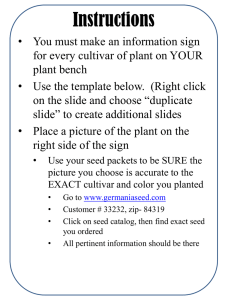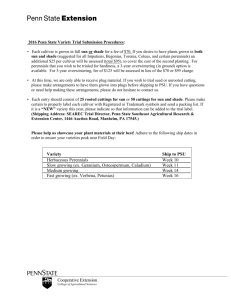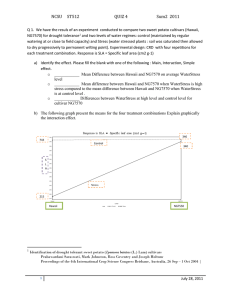Various ways for successful Cultivar introduction in the market
advertisement
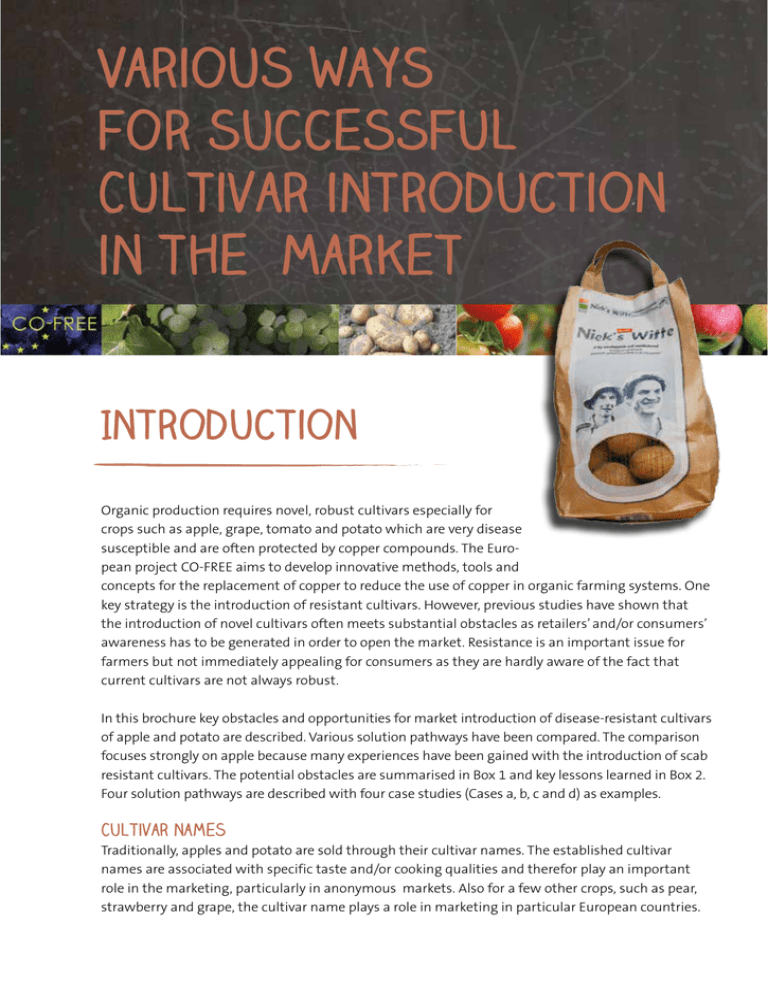
Various ways for successful Cultivar introduction in the market Introduction Organic production requires novel, robust cultivars especially for crops such as apple, grape, tomato and potato which are very disease susceptible and are often protected by copper compounds. The European project CO-FREE aims to develop innovative methods, tools and concepts for the replacement of copper to reduce the use of copper in organic farming systems. One key strategy is the introduction of resistant cultivars. However, previous studies have shown that the introduction of novel cultivars often meets substantial obstacles as retailers’ and/or consumers’ awareness has to be generated in order to open the market. Resistance is an important issue for farmers but not immediately appealing for consumers as they are hardly aware of the fact that current cultivars are not always robust. In this brochure key obstacles and opportunities for market introduction of disease-resistant cultivars of apple and potato are described. Various solution pathways have been compared. The comparison focuses strongly on apple because many experiences have been gained with the introduction of scab resistant cultivars. The potential obstacles are summarised in Box 1 and key lessons learned in Box 2. Four solution pathways are described with four case studies (Cases a, b, c and d) as examples. Cultivar names Traditionally, apples and potato are sold through their cultivar names. The established cultivar names are associated with specific taste and/or cooking qualities and therefor play an important role in the marketing, particularly in anonymous markets. Also for a few other crops, such as pear, strawberry and grape, the cultivar name plays a role in marketing in particular European countries. Three steps to follow Introduction of new cultivars is not easy, but three steps can be recognised. Cultivar introduction is easier if there is clear added value for all chain players. Sometimes a particular marketing strategy can help. Sometimes, the positive effect of particularly the first cultivar introductions may become visible only several years later. In other cases (so-called locked-in situations), innovative concepts are needed. It is important to realise that new concepts need to fit in existing structures (see Box 2). 1. Added value: In the first place, successful introduction of resistant cultivars requires that these cultivars have to be good in many aspects: They must have a minimum level of added values for all chain players. To optimise cultivar introduction, it is necessary to involve traders, supermarkets and other chain players in early phases of cultivar testing. 2. Multiple or specific strategies: Is one strategy sufficient, or are multiple strategies better? Combinations of strategies can strengthen each other. 3. Locked-in situations: develop innovative concepts: The flavour group concept is a strategy that allows the cultivation of multiple cultivars, while addressing the fact that traders and consumers are used to work with limited categories. Hence, the flavour group concept provides a way out of locked-in situations. It is important to realise that it needs to be made tailor-made to specific contexts, luck is needed and sometimes unexpected benefits are gained. Box 1: Potential obstacles Based on various case studies, potential obstacles can be observed. •Link cultivar names to added value (see Case a) •The standards for breeding are already high and will only become higher. Creating added value is very difficult and sometimes more a result of luck. •Often needs to be combined with other marketing strategies. •Well-coordinated marketing concept in combination with a new brand name (see Case b): •It requires a good organisation and funding to support introduction and coordination within the chain. •Innovative marketing concepts (see Case c): •It requires a long period of continuous organisational and financial support and commitment. •It requires both pull and push factors. •It requires a large number of cultivars with different qualities, and a large enough market to buy the produce. •Transform weak traits into unique selling points in the brand name (see Case d). •Requires out-of-the-box thinking. •Introduction via boxes fillers and organic shops, followed by potential upscaling to supermarkets. Case a: the apple Santana > Link cultivar names to added value The simplest way to introduce successfully new cultivars is if a new cultivar has clear added values for all players in the chain (growers, traders and consumers). If all chain players recognise added value for themselves, a cultivar becomes quickly adopted. However, introducing new cultivars based on added value only is not easy. This is illustrated with the introductions of Santana. The cultivar Santana was first introduced into the market in 1996. Its intended added value for farmers was scab resistance, and its taste was good, comparable to the well-known cultivar Elstar. In the next years the market discovered its susceptibility for rotting at the core during storage. Only a few organic growers continued its cultivation and sold the produce through organics shops. In 2006 a Dutch organic farmer discovered that the cultivar Santana had a unique property: low allergenic traits. With this new added value, the advantages outyielded its disadvantages, which are mildew susceptibility next to risk of rotting during storage. About 50 to 70% of the consumers with apple-allergy can eat Santana without problems. It was the first apple cultivar with this trait in the world, which was promoted through including leaflets with the produce. Because of that it received much media attention, which in turn was also extra publicity to other consumers without apple-allergy. One key lesson is: Some added values, like scab resistance are purposefully developed, while other added values can be discovered by co-incidence. Another key-lesson is that it can take time before added-values are discovered. Figure 1: The apple cultivar Santana Box 2: Key Lessons learned With the different cases on apple and potato cultivars various lessons become visible. These lessons are particularly useful when you are experiencing problems with cultivar introduction or in a locked-in situation (when all chain players seem to be stuck in a specific chain model). The main key-lessons are: •There must be a recognised need - a pull factor: For successful cooperation all players need to be inter­ ested, together creating pull factors. The more pull factors the more likely an initiative will succeed. (all cases) •To create pull factors, it is important to involve others: There are two options: a dominant player becomes a big pull factor (case b), or many small players together create a pull factor (case d). •A shared language among chain players and common culture is necessary: Different players in the chain may speak different ‘languages’ / jargon. It is not always easy to understand each other’s jargon (case c). •Without push factor, no new things happen: For new concepts a continuous push over a long period is needed (case c and d). •New concepts need to fit in existing structures: The appropriate economic and political context is needed (case b and c). •Patience is often important: Case studies a and c suggest that various chain players need several years to adapt. > Well-coordinated marketing concept in combination with a new brand name Case b: the apple Juliet ® Well-coordinated marketing concepts, in combination with club cultivars, create an attractive image of a cultivar, making consumers interested and subsequently create demand by consumers. Typically, club cultivars are grown by a limited number of growers on a limited acreage and sold for a higher price compared to the common cultivars. The cultivar Juliet® did not automatically find its way to the market. The cultivar was tested in France but failed in the tests for conventional farming, because its storability and taste were not good enough. Its current success shows that marketing is as important as breeding. The cultivar Juliet®, original name Co-op 43, was developed in the US in the 1970s in a program to develop apple cultivars resistant to scab. The cultivar Juliet® was released only in France, in 1999. The licence for Europe was bought by a French nurseryman. Together with a nursery tree grower and a technician, he set up the cultivar club “Les Amis de Juliet® ”. There was good synergy and commitment among a number of crucial players in the chain and the cultivar club quickly took off. Since 2005 the cultivar Juliet® is cultivated as club cultivar in France. The production of Juliet® is still increasing: from 1,800 tonnes in 2011 to 3,500 in 2012. In 2012 key elements of the club concept were: • Exclusive marketing: partnership with CARDELL export • Controlled cultivation: approximately 80 farmers, only organic, so far only in France • Controlled distribution: 6 packaging stations in France • Wide range of products: various packages, desserts, juices, etc. (Figure 2) • Promotion via: trade shows, supermarkets, specialists shops, press, TV, internet, games and promotional items • Opportunity to become a ‘friend of Juliet®’ • • • Figure 2: A large range of products to promote the cultivar Juliet®. Case c: the apple Flavour GRoup Concept > New marketing concepts to by-pass the cultivar names For cultivar choice, usually organic production chains follow conventional markets. Cultivar names are considered crucial by traders and supermarkets in the marketing of apples. With the flavour group concept, researcher Franco Weibel from organic research institute FiBL in Switzerland found a successful answer to the question how to market new apple cultivars not grown conventionally, with added value for organic growers, but too small acreage in Switzerland to be really interesting for the market. The flavour group concept groups cultivars into three groups indicated with colours on the labels: a) yellow: mild to sweet, b) red: spicy, rather tart and c) green: predominantly tart (Figures 3 and 4). For a market that requires year round big quantities of apples, the concept has the advantage that many new cultivars with similar taste but each cultivated on small acreages can be easily packet and marketed together. In that way, many cultivars can be more easily introduced in the market and more agro-biodiversity offered to consumers. Another advantage is that if more resistant cultivars can be cultivated, a more sustainable production system develops. The larger the number of cultivars that are cultivated, the more difficult it will be for scab resistance to break down. Easier introduction of new cultivars in the market is also a stimulus for breeding. Various factors made the flavour group concept possible: 1) Franco Weibel from FiBL continuously pushed the idea to traders and supermarkets, 2) early 1990’s, the supermarket COOP wanted to improve its profile, 3) many scab resistant apple cultivars became available suited for cultivation in Switzerland, 4) in the same period the government changed its agricultural support system, from supporting quantity to quality, which stimulated apple growers to change to organic with new scab resistant cultivars, and 5) Switzerland has import tariffs on apple. Today, in Switzerland, about 40% of the organically grown apples are scab resistant cultivars, whereas this is only 10% in Germany. Since 2000 the flavour group concept is also used for cultivars produced through integrated apple growing (conventional). The other Swiss supermarket Migros has also developed its own version of the concept in 2002, with two flavour groups. For conventional potato, both supermarkets use various cooking groups, instead of flavour groups. Figure 3: The three flavour labels used by COOP: yellow (mild to sweet) red (spicy, rather tart) and green (tart). Figure 4: The colour concepts used by supermarket COOP. Case d: the potato Niek’s witte > Translate weak traits into unique selling points in the name The late blight resistant potato cultivar Bionica had difficulties to enter the market. This cultivar is a white fleshed potato and hence deviates from what the Dutch consumer is used to consume (preference for light yellow fleshed potatoes). Except resistance to late blight, the cultivar had no other specific added values. In 2007, the Dutch breeding company Meijer and Niek Vos (a biodynamic grower and potato farmer breeder), who jointly bred this cultivar, registered ‘Bionica’. The agreement was that Meijer would cover the conventional markets overseas and Niek Vos would cover the organic market in the Netherlands. When the company Meijer did not see enough market potential, they left the market introduction to grower Niek Vos. Niek tried various market channels: box-schemes, small regional supermarkets and big supermarkets. The supermarket channels were not a success. However, the response in the box-scheme chain was high and overall positive. A certain group of Dutch consumers did not mind the white flesh and sympathised with the story behind this cultivar being a farmer-bred cultivar. It was clear an extra effort was needed to introduce this cultivar. Funding, however, was limited. So it seemed best to change a weak aspect into something special: giving a positive and more personal image to the flesh colour issue. It was decided to replace the cultivar name Bionica by the brand name Niek’s Witte (meaning Niek’s White). And by adding a picture of the father (Niek) and his son who joined the farm management an extra personal element was included. To give the product that was bred, grown and packed on-farm a more natural look, a paper bag was chosen with the story of the breeding process at the backside of the bag. the CO-FREE project Co-Free is a collaborative EU project in which research institutes and commercial companies are working together to develop innovative cultivation methods and alternative compounds for the replacement of copper in organic and low-input fruit, grapevine, potato and tomato production systems. The Louis Bolk Institute is one of the partners in this project and involved in developing strategies for market acceptance of new resistant potato cultivars. com Authors: Edwin Nuijten, Arend Zeelenberg, Leen Janmaat, Edith Lammerts van Bueren For more information about this project please contact Louis Bolk Institute, Hoofdstraat 24, NL-3972 LA Driebergen, The Netherlands tel: +31 (0) 343 523 860 or email: info@louisbolk.nl See also: www.co-free.eu This brochure is co-sponsored by Figure 5: The developed packaging material for the potato cultivar Niek’s Witte This project has received funding from the European Union’s Seventh Framework Programme for research, technological development and demonstration under grant agreement no 289497
